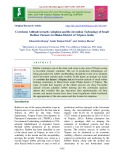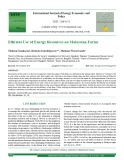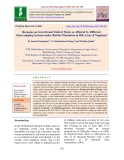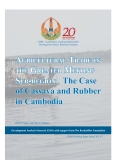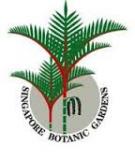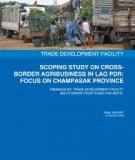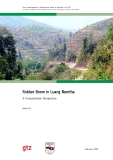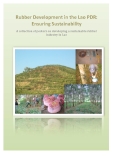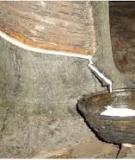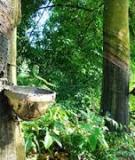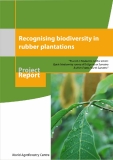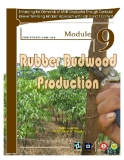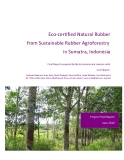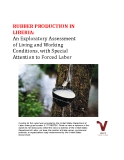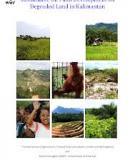
Rubber farming
-
The study revealed that majority of the rubber growers are show Favorable attitude towards adoption rubber farming and the correlation analysis depicts that variables like age, education, farm mechanization, off farm income and annual income have been found significant which facilitated the appropriation of the reinvention and that fostered its adoption.
 6p
6p  cothumenhmong9
cothumenhmong9
 04-01-2021
04-01-2021
 7
7
 2
2
 Download
Download
-
The purpose of this study is to discover an approach where the outputs of the farms are maximum at the minimal input. Malaysia is well known for its crop (such as rubber, rice, palm oil, tea). Prior studies show that due to the climate change, there are likely chances that the farms of Malaysia will go extinct. In this study, the main focus is to efficiently use the energy resources to save it for the future in a prolonged manner. The data was collected from the website of Department of Statistics Malaysia, Official Portal. The data was taken for rubber and crops category.
 8p
8p  partimesinhvien
partimesinhvien
 13-05-2020
13-05-2020
 20
20
 0
0
 Download
Download
-
A field experiment was conducted during the kharif season of the year 2017 and 2018 at the experimental farm of Krishi Vigyan Kendra, Mokokchung, Nagaland to assess the response on growth and yield of maize crop as affected by different intercropping system under rubber plantation. The experiment was laid out in “Randomised Block Design” with seven treatments and three replications. The treatments include sole maize, maize + frenchbean, maize + groundnut, maize + paddy, maize + ginger, maize + greengram and maize + turmeric.
 7p
7p  quenchua2
quenchua2
 18-12-2019
18-12-2019
 16
16
 0
0
 Download
Download
-
Smalholder rubber farm has been adopted and rapidly developed in Quang Binh Province, playing a very important role in the economic development of the locality such as creating jobs, increasing income for rural laborers, contributing to hungereradication and poverty reduction.
 13p
13p  byphasse043256
byphasse043256
 12-01-2019
12-01-2019
 29
29
 2
2
 Download
Download
-
A key reason is that agricultural production has few technical (dis) economies of scale, implying that a range of production forms can coexist. A look at the 300 or so publicly listed companies in table 4 illustrates this point. Even though farming accounts for 22 percent of the global agricultural value chain, it makes up a mere 0.2 percent of equity market capitalization. As of October 2009, there were only seven publicly listed farming companies worldwide, three in Brazil and Argentina and four in Ukraine and Russia.
 62p
62p  thieubaotrang
thieubaotrang
 23-04-2013
23-04-2013
 46
46
 6
6
 Download
Download
-
Case studies of projects in 7 countries suggest that widespread concern about large-scale farming being associated with potentially large risks is justified.
 39p
39p  thieubaotrang
thieubaotrang
 23-04-2013
23-04-2013
 64
64
 4
4
 Download
Download
-
In Africa after independence, many countries attempted to ‘modernize’ their agricultural sectors through large-scale farming, providing subsidized credit, machinery, and land. These efforts almost universally failed (Eicher and Baker 1992). One of the largest and most well-documented cases was mechanized large scale sorghum and sesame production in Sudan that originated in attempts by financiers from the Gulf following the 1970s oil price spike, to transform the country into a regional breadbasket.
 135p
135p  thieubaotrang
thieubaotrang
 23-04-2013
23-04-2013
 56
56
 5
5
 Download
Download
-
Rubber provides an interesting contrast. Large rubber plantations often opened areas by establishing processing facilities, markets, and roads via settlement programs where locals or migrants provide labor to establish the plantation and acquire land as outgrowers. In some cases, as in the FELDA program in Malaysia and the Indonesian transmigration program, these were state sponsored.
 26p
26p  thieubaotrang
thieubaotrang
 23-04-2013
23-04-2013
 110
110
 3
3
 Download
Download
-
The perennial crop sector in Southeast Asia illustrates the plantation model of large-scale farming. Malaysia and Indonesia produce nearly 90 percent of the world’s palm oil, production of which has expanded rapidly in response to growing global demand for edible oils and strong government support. In Indonesia, planted area more than doubled from about 2.9 million ha in 1997 to 6.3 million ha in 2007. In contrast to annual crops, oil palm is highly labor intensive and the industry is estimated to have created an estimated 1.7 to 3 million jobs.
 179p
179p  thieubaotrang
thieubaotrang
 23-04-2013
23-04-2013
 50
50
 5
5
 Download
Download
-
Eastern Europe has undergone far-reaching transition from the former Soviet system of collective and state farms to new agrarian structures. This has unfolded in many ways, depending on countries’ factor endowment, institutional structure, the share of agriculture in the overall labor force, infrastructure, and the way the reforms were implemented. In areas of low population density where collectives were divided into small plots allocated to members, the plots were quickly rented back by companies with access to finance and machinery.
 26p
26p  thieubaotrang
thieubaotrang
 23-04-2013
23-04-2013
 56
56
 1
1
 Download
Download
-
Competitive land lease markets, with contracts renewed annually, imply that at least part of any efficiency savings of Argentine’s large operators are passed on to landowners, who often receive lease payments above what they may have been able to earn by self-cultivation. With land ownership remaining constant, agricultural production has become more concentrated -the 30 largest companies control some 2.4 million ha (Manciana et al, 2009). Finally, positive experiences with investment in large-scale farming have been recorded in Peru’s Pacific region.
 79p
79p  thieubaotrang
thieubaotrang
 23-04-2013
23-04-2013
 46
46
 4
4
 Download
Download
-
Finally, in Southern Brazil, production of sugarcane, often for ethanol, is expanding rapidly, under a more mixed regime. About half of production is from medium farmers with an average of about 50 ha. Much of the rest produced in vertically integrated operations with mills on land they manage and operate. While average operated size per mill is some 13,000 ha, some very large operators farm over 300,000 hectares. Argentina presents a somewhat different picture.
 21p
21p  thieubaotrang
thieubaotrang
 23-04-2013
23-04-2013
 56
56
 3
3
 Download
Download
-
Second, a discussion of key determinants of the way the agricultural sector is organized highlights that, while large operations have historically had a dominant role in plantation crops, agricultural production, in contrast to marketing or processing, is not characterized by significant economies of scale.
 111p
111p  thieubaotrang
thieubaotrang
 23-04-2013
23-04-2013
 68
68
 8
8
 Download
Download
-
While there is little evidence of significant recent changes in agrarian structure in land scarce countries (Lipton 2009), many land-abundant countries are characterized by rising investment in large-scale farming based on a nonfamily corporate model, a trend that can but need not be accompanied by growing concentration of land ownership (Deininger et al. 2011, UNCTAD 2009). Table 1 provides characteristics of a sample of very large farming operations in land abundant countries or regions within countries.
 0p
0p  thieubaotrang
thieubaotrang
 23-04-2013
23-04-2013
 46
46
 3
3
 Download
Download
-
Against this backdrop, this paper has three objectives. First, we review recent evidence on the establishment and evolution of large farms across regions. This illustrates that such units often emerged in response to policies or market failures related to availability of infrastructure, technology, and property rights.
 36p
36p  thieubaotrang
thieubaotrang
 23-04-2013
23-04-2013
 50
50
 5
5
 Download
Download
-
However, disillusion with the limited success of smallholder-based efforts to improve productivity in Sub-Saharan Africa (Collier and Dercon 2009) and the apparent success of Brazil in establishing a vibrant agricultural sector based on much larger farms have led some countries to view the development of large- scale mechanized farming as the path to modernization of the sector.
 53p
53p  thieubaotrang
thieubaotrang
 23-04-2013
23-04-2013
 85
85
 4
4
 Download
Download
-
Rubber production on small-scale farming systems in Thailand is a secured way for farmers to gain constant income for their livelihood. Besides, rubberwood farming systems are easy to maintain because silviculture costs are mainly present at the preparation and planting stages. Economic risks to small-scale rubber farmers are not that significant because farmers always have the possibility to substitute their income source by switching into alternative farming products.
 58p
58p  thieubaotrang
thieubaotrang
 23-04-2013
23-04-2013
 76
76
 2
2
 Download
Download
-
While the rubber trees are immature, selected legume cover crops such as Pueraria phoseoloides, Culopogonium mucunoides and Centrosemu pubescens may be grown on rubber plantations. Intercropping can be carried out with coconut trees and banana plants within the rubber plantation. Sometimes banana alone is used as an intercrop. Intercropping can also be carried out with rice, longgong, mangosteen, satow, bamboo, jampada, riang, durian, pineapple, coffee trees, neem and hot pepper (ITTO, 2000).
 0p
0p  thieubaotrang
thieubaotrang
 23-04-2013
23-04-2013
 57
57
 3
3
 Download
Download
CHỦ ĐỀ BẠN MUỐN TÌM









